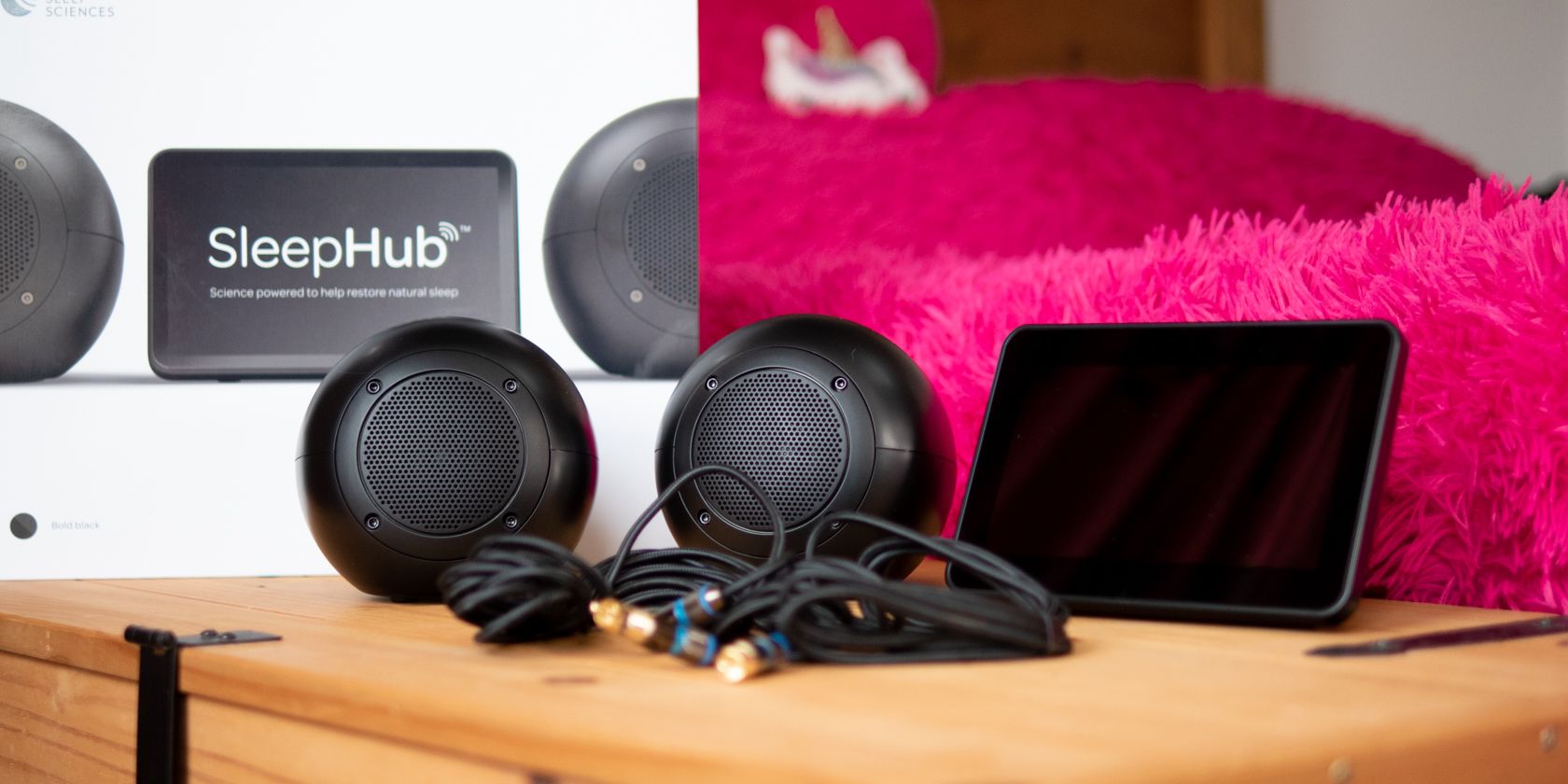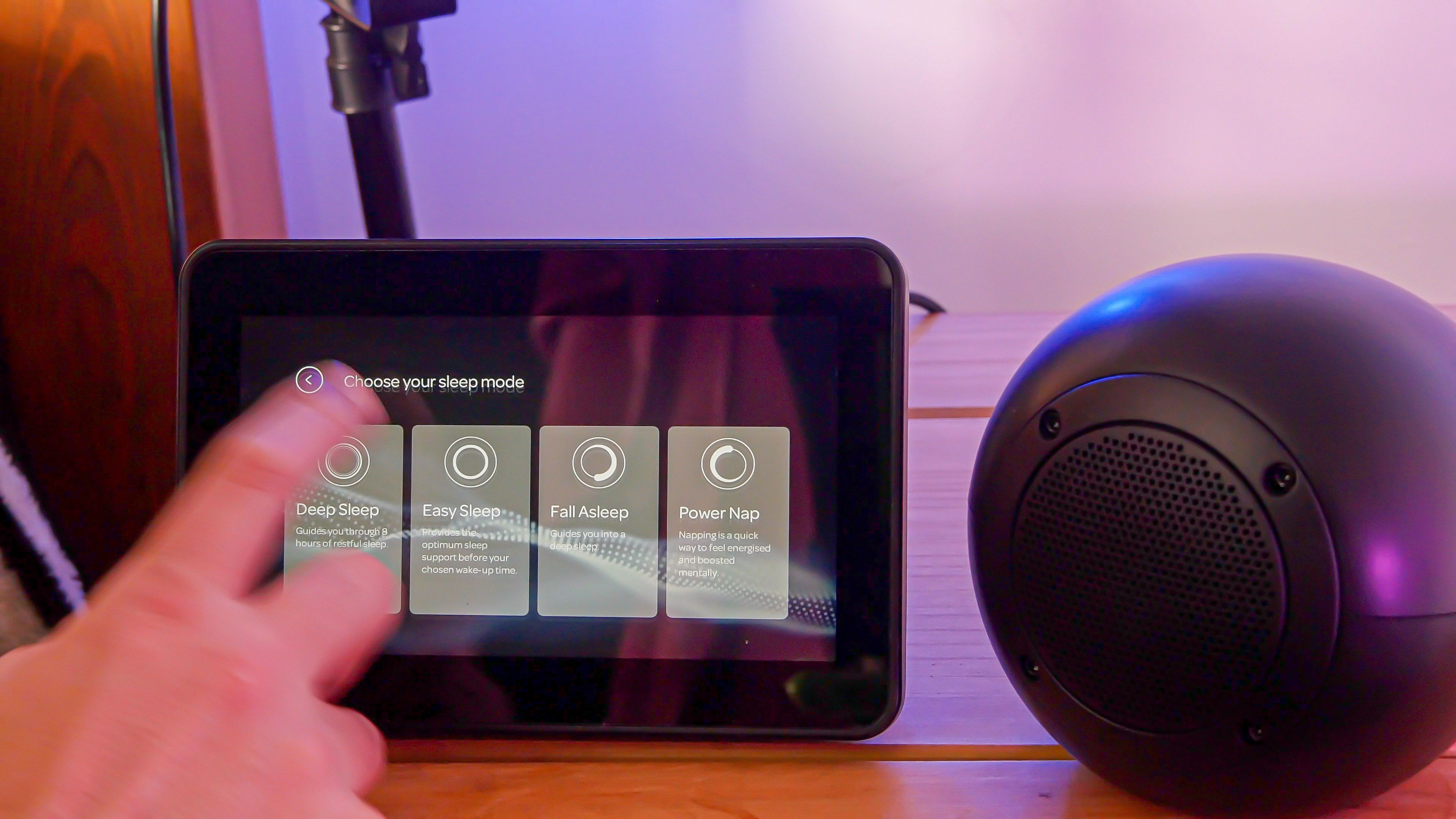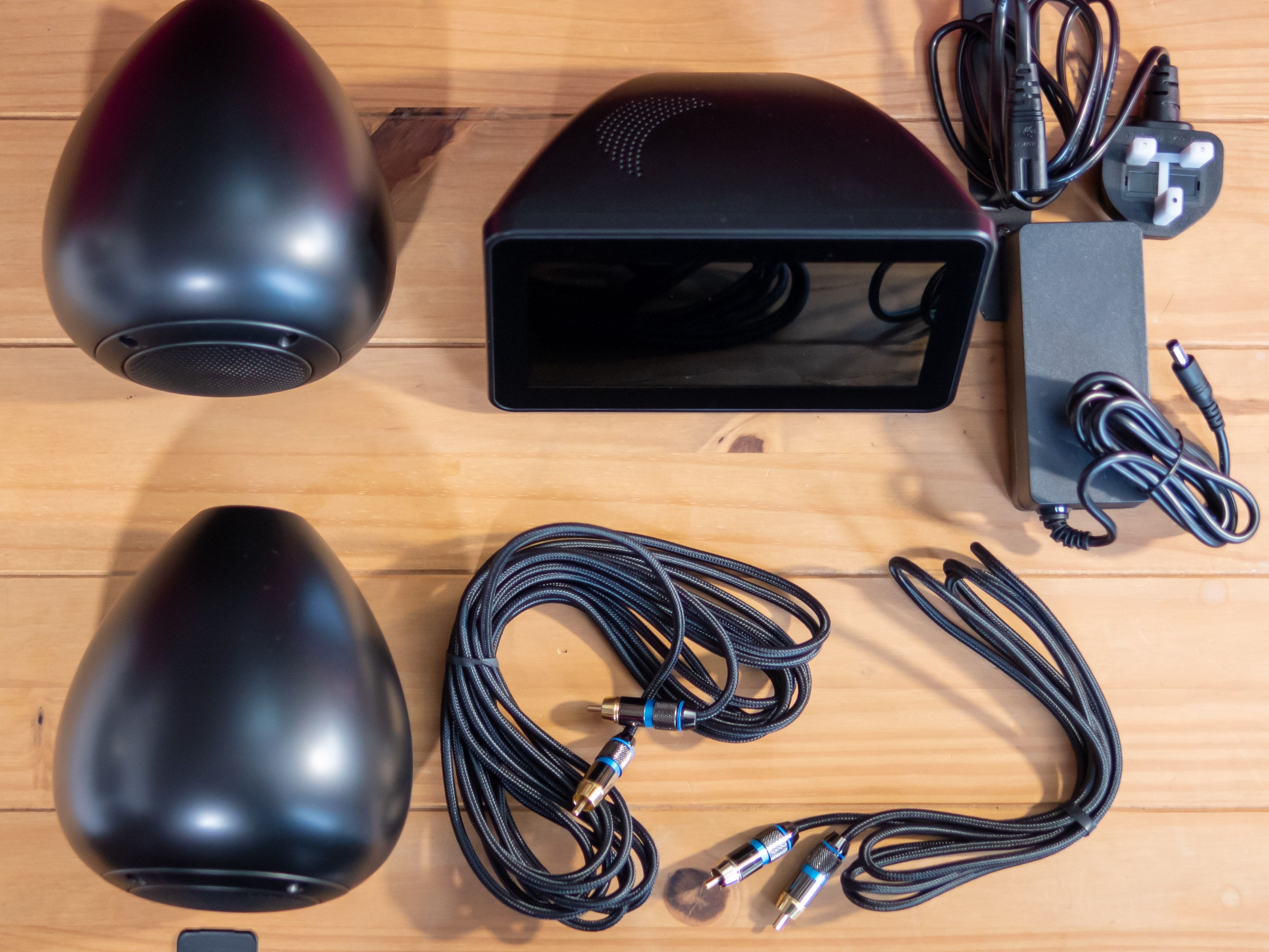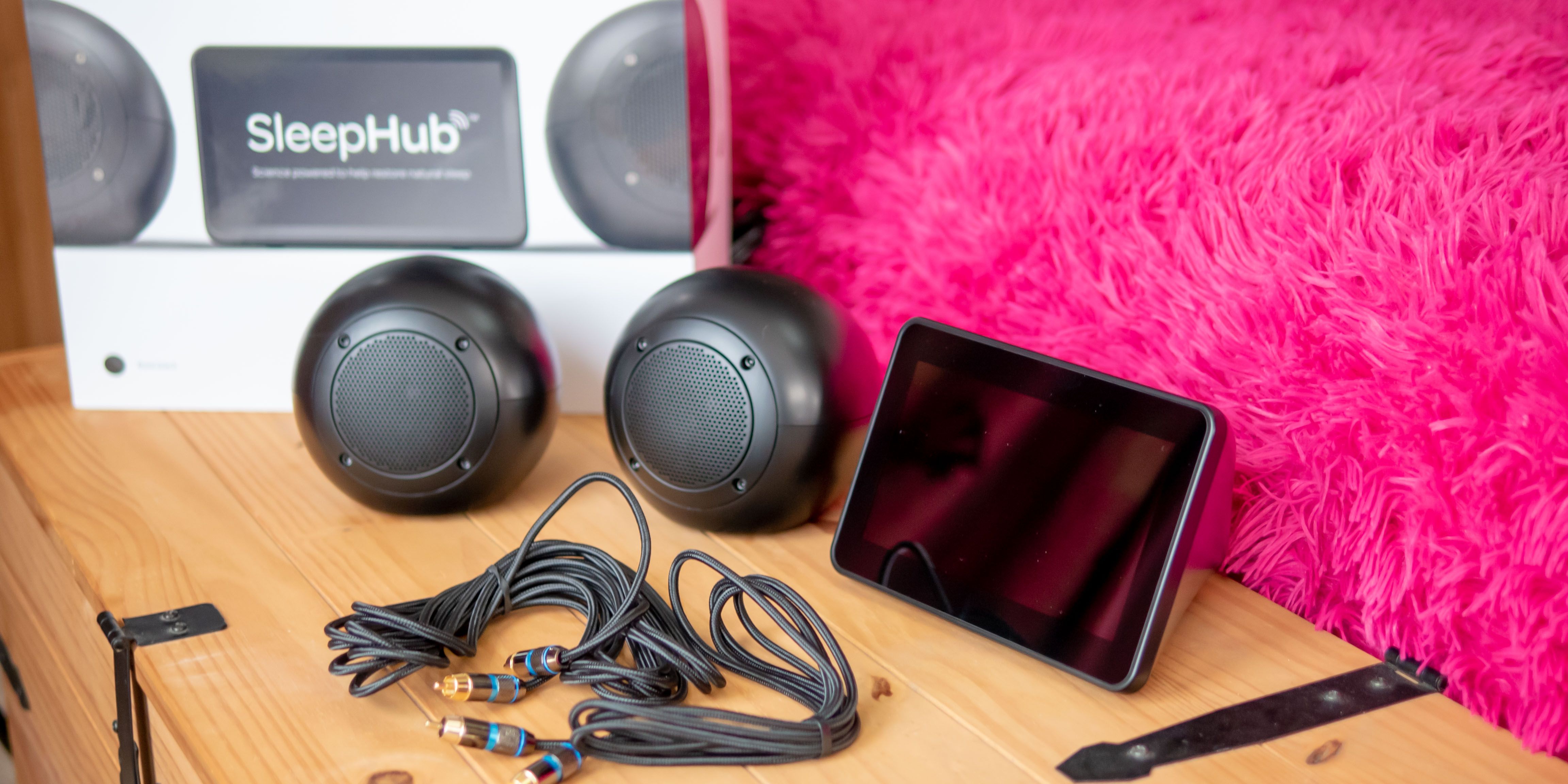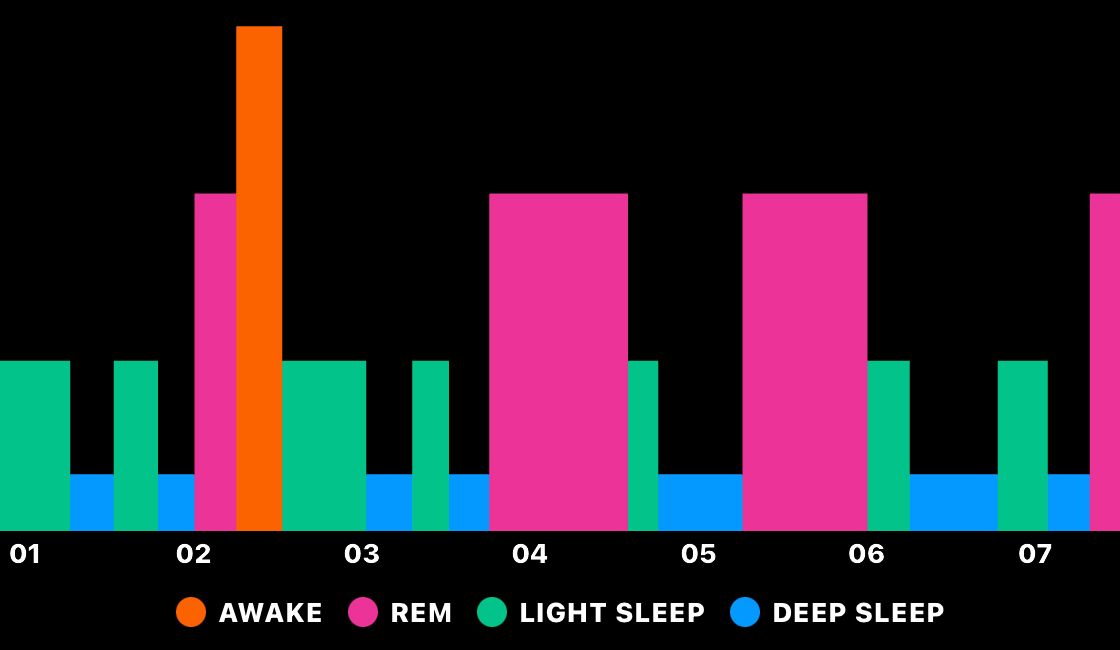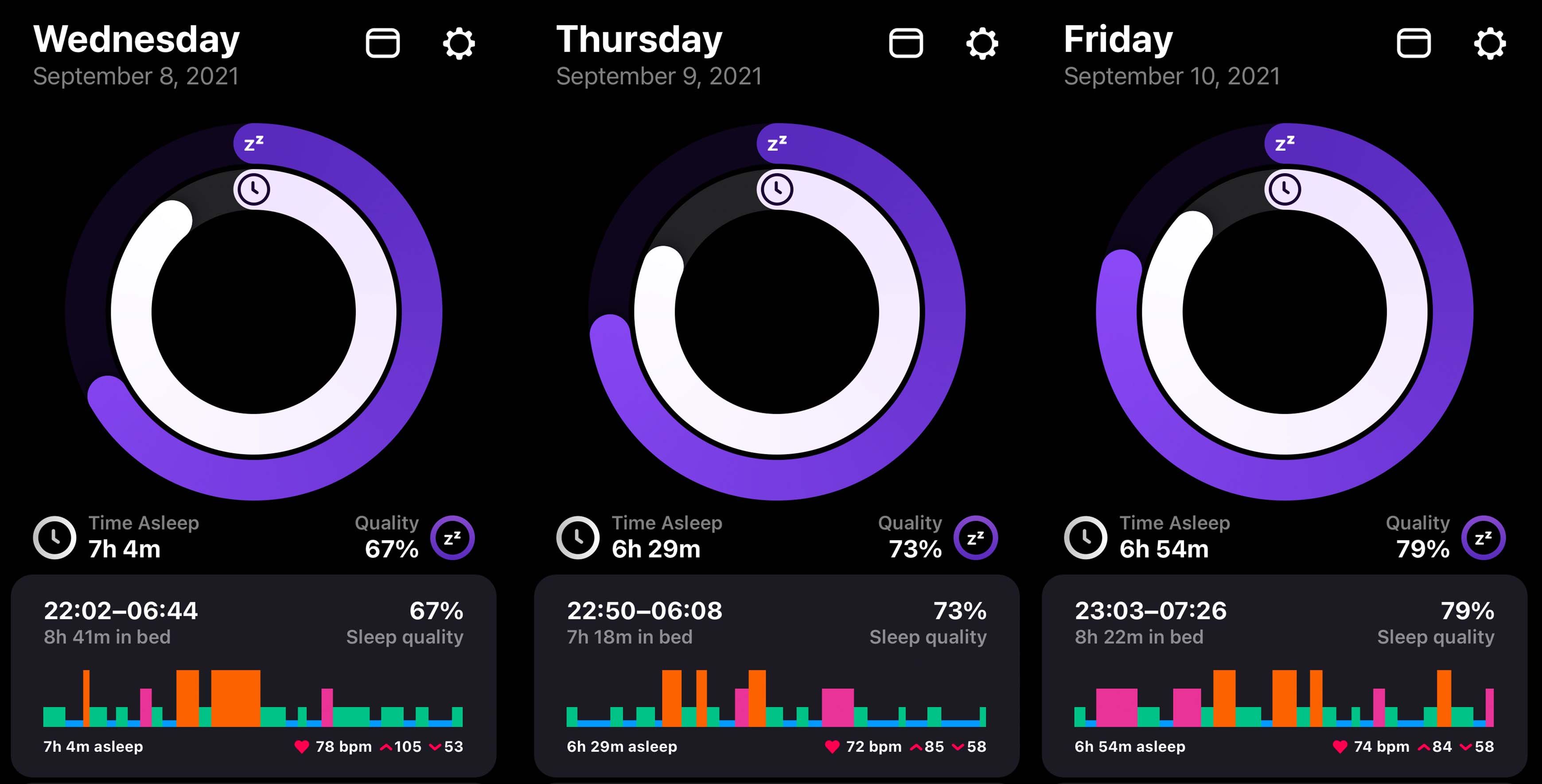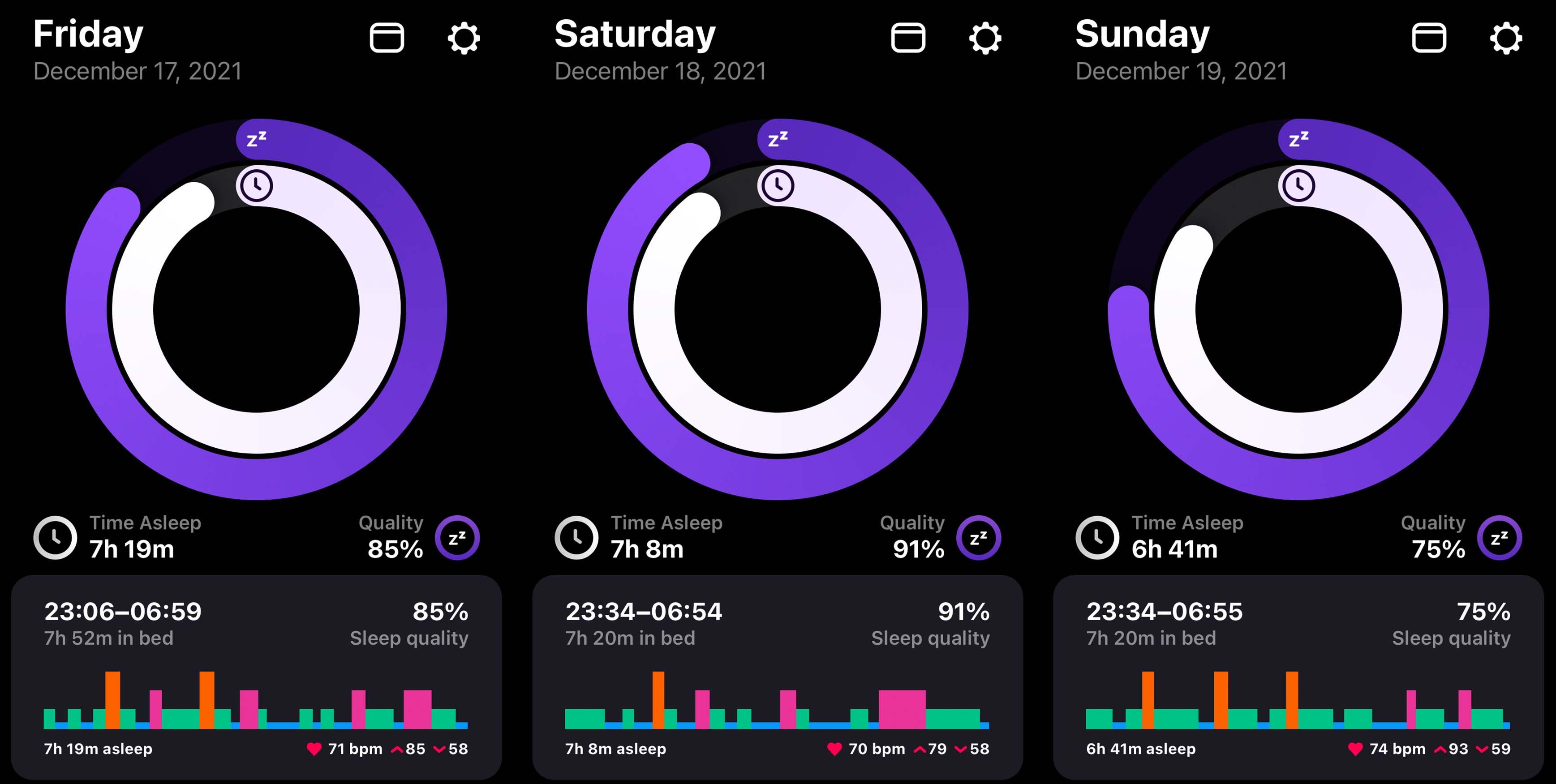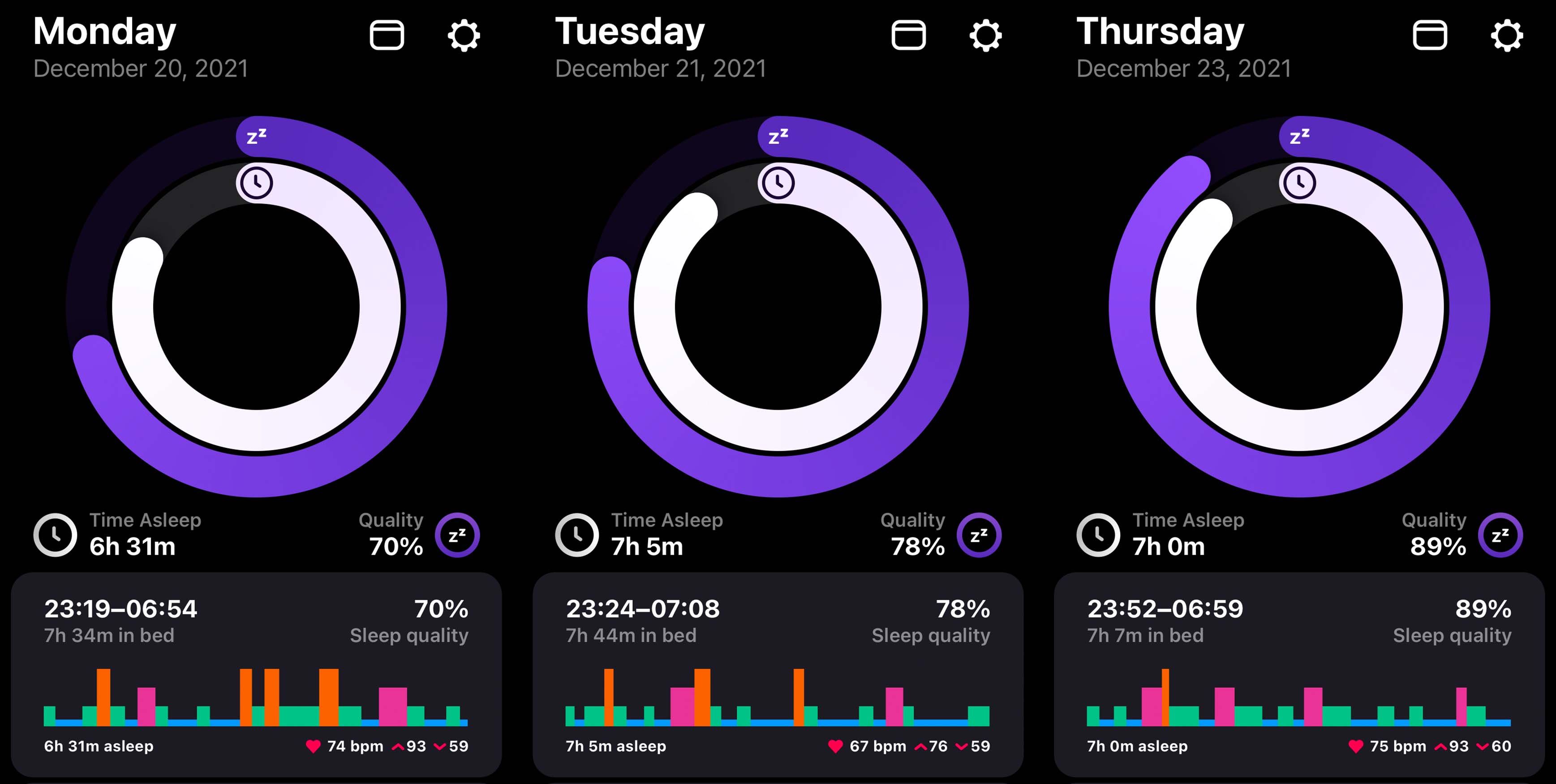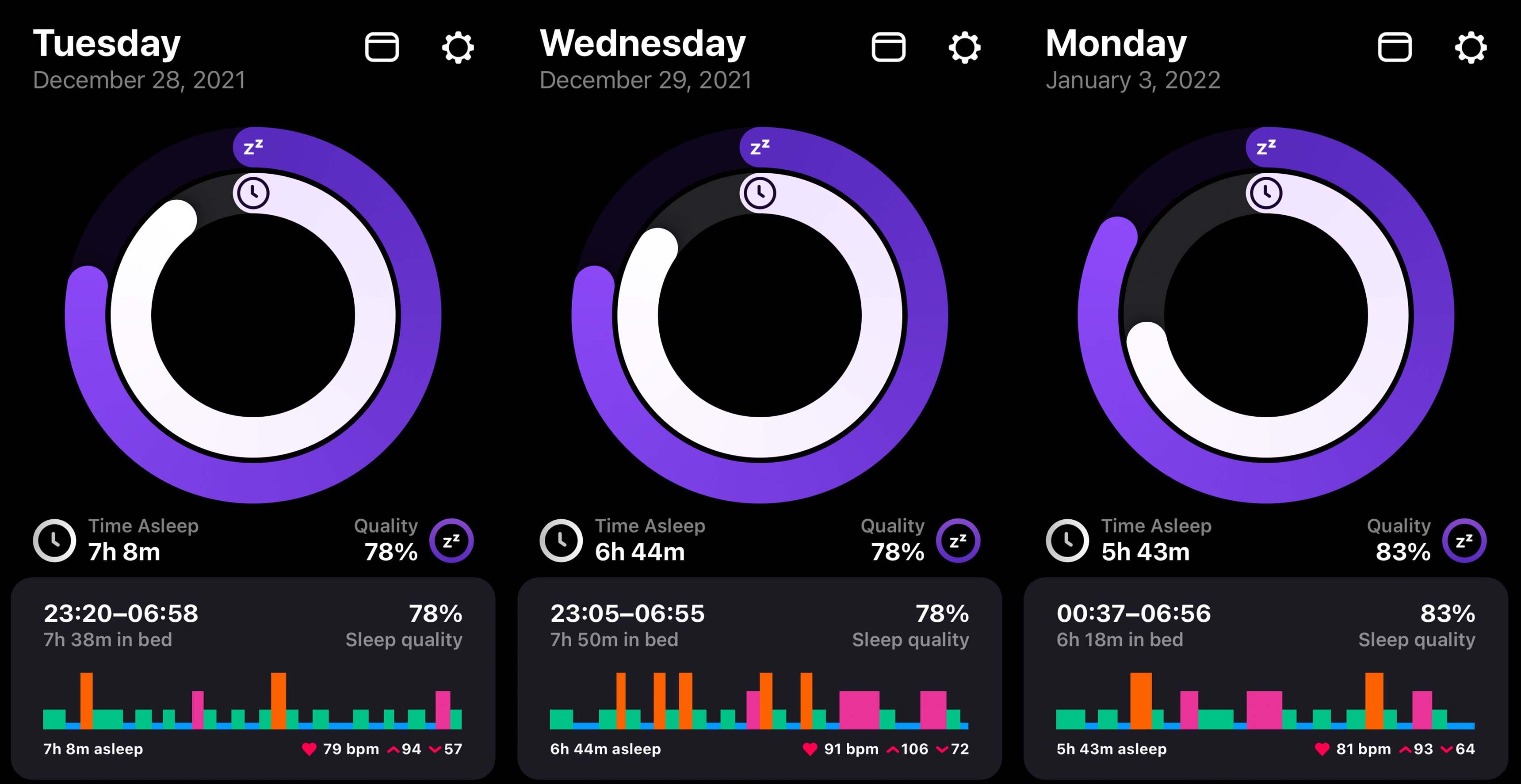SleepHub
The SleepHub uses a combination of soothing noise soundscapes and tonal beats to help you get more sleep and push your brain into a natural sleeping pattern. It's an easy-to-use device with premium hardware, backed by proven research, and I definitely experienced better sleep while using it. I slept longer, better, and remembered more dreams. But it won't solve every sleep problem, so you might want to test the water with some free Spotify noise tracks before taking the plunge with SleepHub.
- Brand: Cambridge Sleep Sciences
- Connectivity: Bluetooth, Wi-Fi
- Very simple to use
- Speakers offer great sound quality
- Seems to actually work
- Wi-Fi connectivity allows for potential updates down the line
- Expensive
- Currently limited feature set
Are you having trouble sleeping lately, perhaps waking up in the middle of the night due to anxiety about, well...everything? Cambridge Sleep Sciences thinks they might have the solution with the SleepHub. It's a premium white noise machine that reprograms your brain while you sleep, restoring a natural sleep pattern to feel perfectly rested when you awake.
Seriously.
My Qualifications
Why should you listen to me when it comes to evaluating this sort of device? I'm not a sleep scientist. However, I have spent much of my life researching sleep and the various cycles and phases. From a young age, I've kept dream diaries and dabbled in the world of lucid dreaming (becoming conscious within a dream, in order to control it). This involves learning about things like when dreaming is most likely to occur, how to increase dream recall frequency, and becoming more aware of brain activity as the sleep cycle begins and you slip into a state of hypnagogia.
I'm also extremely skeptical, so you can trust me to sort through the pseudoscience and know what it means for a paper to be published and peer-reviewed.
What is The SleepHub?
In the SleepHub box you'll find two large, heavy, egg-shaped speakers, plus the base unit, power supply, and two lovely braided RCA cables. One of these is short (about a meter), and the other much longer (three or four meters)—plenty long enough to go from one side of a double bed to the other.
You should plug in the base unit and one speaker on a bedside table, then place the other speaker on the opposite side of the bed. Ideally, it should be placed in a similar location, but you can adjust the speaker balance if it needs to be further away.
SleepHub runs a custom Android install, but it's completely locked behind a kiosk mode, so don't expect to sideload apps onto it. The SleepHub has one purpose, and one only. The screen will sleep after a very short time—about five seconds of inactivity—and wakes up immediately with a single tap of the screen. There's no internal battery, so it needs to be plugged in at all times.
Using the SleepHub
SleepHub offers four modes of operation, all of which are accessible within a few taps of the screen:
- Deep Sleep is the recommended program, suitable for those who are able to sleep a full 8-hours every night. This was the mode I mostly tested with and will offer you the best experience.
- Easy Sleep is a dynamic program that adjusts to your specified wake-up time. If you need to get up at a set time, and don't always go to bed at the same time every night, this is your best option. It'll tailor the sleep phase cycles to match however long you have to sleep.
- Fall Asleep mode is a simple two-hour program that should push you into your first deep sleep phase. If you generally don't wake up during the night or don't want to sleep with noise all the time, this could be ideal.
- Power Nap is a 30/45/60 minute nap program. Napping isn't something I've ever done or felt the need to, so I didn't test this feature—I would have no point of comparison.
Other configurable options include the alarm sound, of which there are a number of calming, inoffensive sounds to choose from; as well as your chosen soundscape. The soundscape selection is a little more limited than I would have liked, and currently consists of:
- White, pink, or brown noise
- Train tracks
- Stream
- Ocean
- Mountain
- Rain
- Wind
You can connect the SleepHub to Wi-Fi, but this is only useful for synchronizing the time (although admittedly, that's quite an important feature to have for an alarm clock). You can also adjust the volume of the soundscape vs sleep tones, alarm, and speaker balance. It's really quite simple to operate, which is great, because the last thing you want to be doing before bed is fiddling with yet another smart device.
The Science of SleepHub
I'm not going to cover the benefits of getting enough (and good) sleep, because that's all well established and I doubt you'd be reading this review if you were skeptical of that. However, there are two things going on with the SleepHub that we should talk about.
The first is the "soundscape", or noise track. Contrary to popular belief, not all noise is bad for sleep. Some sounds are designed to trigger a response by stimulating our brains—such as a baby crying, dog barking, or fire alarm. But repetitive sounds can in fact help you to sleep better, by masking out other unwanted noises. The SleepHub offers a number of different soundscapes, so you may need to experiment to find which suits you best. While the sound of a babbling brook isn't even remotely soothing to me, I found train tracks to be fun, though my favorite remains some generic brown noise.
If you wondering what the difference between white, pink, and brown noise is, it's just a matter of the frequencies involved. White noise is the highest frequency, similar to TV static or rain. Brown noise is the lowest frequency—like a deep thundering waterfall or airplane. Pink noise is somewhere in between the two.
That said, a white noise machine is hardly unique and certainly not enough to justify the price of the SleepHub. In fact, you can easily find 8-hour long noise tracks on Spotify, or free apps to do the same job if you'd like to try sleeping with it.
The second and arguably more important feature of the SleepHub is what Cambridge Sleep Sciences calls "pure tones", but you might be more familiar with terms like binaural beats, monaural beats, or isochronic tones. These are all similar but unique concepts that involve playing two different frequency tones, the difference of which corresponds to a particular operational state of the brain. The idea is that by listening to these tones, the brain will attempt to naturally synchronize to the difference in frequencies, thereby shifting it into a particular state.
For instance, during the REM (dream) cycle, the brain operates at a normal frequency, similar to waking life—alpha and beta waves. This makes sense: dreaming uses all the same parts of the brain as being awake, the only difference being that your body is paralyzed and the part that controls critical thinking is shut off—hence why most people don't know they are dreaming, and weird and wonderful things seem quite normal at the time. But during deep sleep, the brain literally slows down, and operates at a much lower frequency: delta waves.
During a full night's sleep, your brain cycles through each sleep stage multiple times—but it changes throughout the night. Initial REM cycles are short, but get longer as the night goes on. So you're more likely to have long, elaborate dreams if you get a full night's sleep.
This is the secret sauce in the SleepHub device. The Pure Tones of the SleepHub change throughout the night, modulating to shift frequencies and synchronize your brain into the ideal sleep pattern. REM is critical for memory function—that much is known—and it could be that dreaming is simply the brain's way of tidying up as it shifts data around.
At this point, you're probably getting a little skeptical—I know I was. The science of using differential audio frequencies to shift brain state is called "auditory brainwave entrainment", and there does appear to be a small number of studies into their effectiveness. For instance, delta waves (or slow-wave sleep music, SWS) induce a deep sleep; while alpha waves induce better cognition. These aren't large-scale studies, but do offer some solid evidence for entrainment.
I will however add that when it comes to adjusting your mood, the science is quite clear: this is a placebo. The operating frequency of the brain doesn't correspond to emotions, so you can't just listen to a binaural beats track and feel better. Well, you can try, but any effects are entirely in your mind and not physiological.
Cambridge Sleep Sciences also claim that playing these tones to both the left and right ears helps to synchronize and strengthen the connection between the left and right sides of your brain, thereby increasing a whole host of brain functions that require both hemispheres to cooperate. That's a lot more difficult to prove one way or another, and I couldn't find any evidence for the claim.
While the SleepHub creators haven't formally published a paper on the effectiveness of the SleepHub, they do mention an independent study in which they claim, for people with at least three months of insomnia, 92% saw an improvement to their sleep of an average of 155 minutes more time asleep, 76 minutes less time awake, and 55% reduction in times awoken. That's some impressive results, though again this wasn't published nor peer-reviewed. When I asked about this, they said they're about to do a clinical trial to validate the results, and that would be published.
Still, the wider science around entrainment appears to be solid. It may actually be possible to reprogram your brain for better sleep using sound.
Sleeping With the SleepHub
Generally speaking, I sleep well. Since I work from home, I don't use an alarm, and naturally tend to wake up 7-8 hours after I fall asleep. However, I do sometimes wake up in the middle of the night and find it hard to fall asleep again. My mind wakes up, and simply won't shut up. In that respect, the brown noise track is probably what benefitted me the most, as something to drown out the thoughts and give my mind something else to focus on.
To try and be a bit more empirical about things though, I used a third-party sleep tracking app called Pillow, which uses data from my Apple Watch to accurately track sleep phases, time asleep, and assign an arbitrary score.
As a baseline point of comparison, I pulled some sleep stats from a few consecutive days in September. I didn’t use the data from the month prior to using this because it had been particularly bad—the dog was waking me up four or five times a night, so it wouldn't have been a fair comparison. (Note; I rounded times to the nearest 15 minutes to make my calculations easier; I didn't always use consecutive days because my Watch wasn't charged, and discarded any outlier results where I'd been drinking heavily)
My baseline score is an average 6 hours 45 minutes asleep, with 73% quality. That’s pretty good, I'd say.
Next, I started using the SleepHub, with the full 8-hour program. I should be clear that there is an adjustment period. We are creatures of habit, so anything novel during sleep is going to deprive you of sleep until you get used it. Sure enough:
During these three days of adjustment, my average time asleep went down to 6 hours 15 minutes, and 68% score. Again, this was expected.
Finally, I took more data after I got used to sleeping with it. And here’s what I found:
Averaged across these six nights prior to Christmas, my sleep improved to around 7 hours and 89% score; that's both longer and better than my control sample.
Finally, I switched it off for a few more days to validate the results.
Sure enough, average sleep time dropped down to 6.5 hours, though the quality remained high at 80%.
Clearly, the SleepHub is helping me to sleep better. To be honest, I wasn't expecting much—like I say, I sleep pretty well anyway. Anecdotally, days when I had the SleepHub on, I felt better rested, woke up feeling refreshed, and was able to remember my dreams more frequently (which means I was consistently hitting longer REM cycles).
Sound Quality
Although the SleepHub isn't marketed as simply a nice pair of speakers to play music on, and they're clearly not portable or designed for anything other than staying by your bedside, they do offer Bluetooth connectivity. So you can enjoy a bit of music in bed, or perhaps an audiobook or podcast. It also means I can run them through a standard selection of sound tests, and use audio tracks that I'm more familiar with.
The sound quality from these speakers is absolutely divine. The sibilance from spoken sounds will send shudders down your spine, so if you're into ASMR, I think you'll love these. The bass is impressive for the size, though still a little lacking for my (admittedly extreme) tastes. For all genres of music, audiobooks, podcasts, these are simply great speakers.
On the downside, there is a significant latency when watching video. This would indicate it's not using the latest Bluetooth codecs. So while it's great for listening to audiobooks or music, I did find myself temporarily killing the Bluetooth connection if I opened up YouTube.
Should You Buy The SleepHub?
Will it help you sleep better? It certainly has helped me, but your experience may vary. Is it going to solve every kind of sleep problem? Not at all. Will it actually reprogram your brain? The science appears solid, and my results were clear, but it's still on the fringes of research, and there's much about sleep that we don't yet understand. But what I can tell you is that the speakers are great, and it's a very easy-to-use product.
My only complaint would be a lack of variety and features. What it does, it does very well—but it feels like there’s so much more that it could be. The SleepHub feels like a very singularly focussed product, but as a “hub” I would like to see more added to encompass all aspects of sleep and relaxation. More soundscapes, for instance—there were only two that we enjoyed. For shorter sessions, a guided meditation series would a fantastic addition and wouldn’t be hard to implement: products like Morphee have done this well. Maybe even the ability to track your sleep with a USB sensor that slips under your mattress. You could opt-in to sleep experiments that further validate the science.
Unfortunately, when I spoke to the SleepHub creators, they said there weren’t any planned firmware updates for the device and that the soundscape database on this couldn’t be updated.
That said, Cambridge Sleep Sciences have a new product launch planned for Spring, called the SleepHub Anywhere. It's a portable device that can pair with your choice of speakers or Bluetooth earbuds and uses an app rather than a built-in touchscreen for control. It should bring the cost down significantly, and have the ability to download more soundscapes.
Finally, for those on a budget who would like to try out something similar, you'll find a full 8-hour sleep cycle program with isochronic beats on YouTube, from Jason Lew Mind Amend. You could play that through a decent pair of speakers you already own, mix it with your choice of brown noise, and perhaps get the same effect as SleepHub.
Ultimately what makes the SleepHub stand out is the ease of use and simplicity of features: tap, slide, sleep. You're not going to get mail or Slack notifications, and there's no fussing around before bed or making sure the battery charged.

